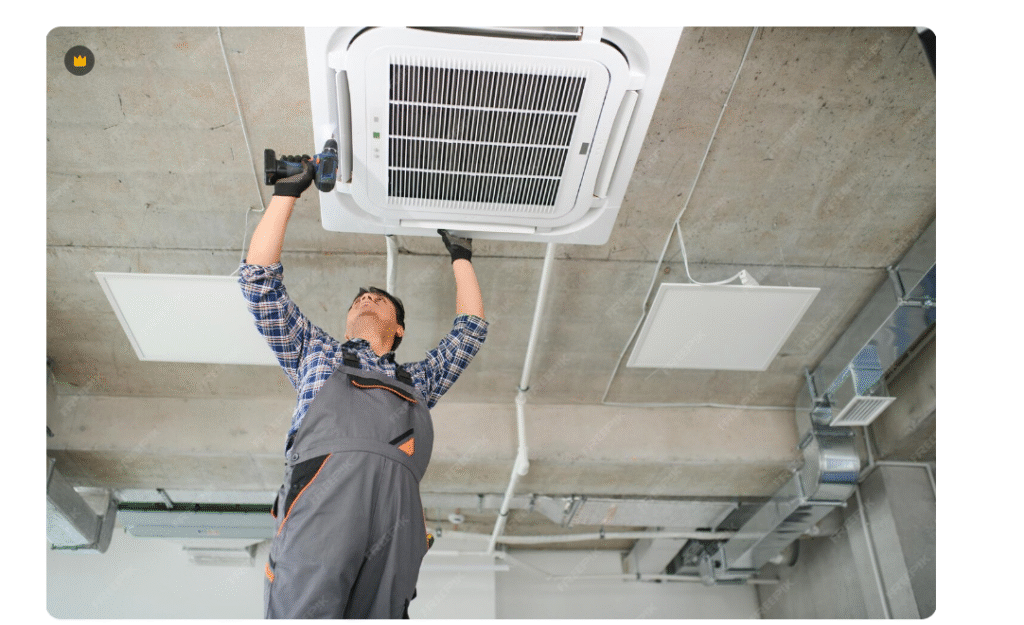HVAC Technician Job Description: Duties & How To Become One

Table of Contents
- What Does an HVAC Technician Do?
- HVAC Technician Job Description Template
- HVAC Technician Education
- HVAC Technician Training & Certification
- HVAC Technician Soft & Hard Skills
- HVAC Technician Resume Examples
- Career Paths in HVAC
- Your HVAC Tech Next Steps: Get Certified, Get Hired, Get Paid
- FAQs about HVAC Technician Job Description
Becoming an HVAC Technician is an appealing option for many entering the skilled trades. According to the U.S. Bureau of Labor Statistics, employment for heating, ventilation, and air conditioning specialists is projected to grow steadily over the next decade (8%). That means strong job security, competitive pay, and opportunities to work across residential, commercial, and industrial settings.
To land a role or advance your career, you’ll need a clear understanding of the typical HVAC Technician job description — including day‑to‑day responsibilities, training requirements, and the skills potential employers look for.
This guide breaks down the full HVAC Technician job description for 2025, including:
- Daily hvac technician duties.
- Educational hvac technician requirements.
- Hvac service technician resume examples to follow.
- Career progression steps from entry-level apprentice to senior technician.
- What employers expect and look for.
- Key certifications to pursue (like EPA 608 certification).
- How to position yourself for long-term success in the HVAC industry.
Looking for an easier way to manage payments in your business? Give Invoice Fly’s Invoicing Software a try — it’s simple to use and completely free.
What Does an HVAC Technician Do?

An HVAC Technician is a professional who specializes in installing, maintaining, and repairing heating, ventilation, and air conditioner systems. These systems include furnaces, heat pumps, boilers, and central refrigeration system units. HVAC Techs ensure climate control systems operate safely, effectively, and efficiently, providing essential service to a wide range of settings across the United States.
A typical day for HVAC Techs involves:
- Diagnosing complex mechanical failures and electrical issues in existing hvac installations.
- Performing preventative maintenance and seasonal tune-ups on residential and commercial units.
- Reading and interpreting blueprints and technical schematics to plan HVAC installations and service calls.
- Using specialized tools (like a multimeter) to test and ensure components are functioning correctly.
- Following strict safety regulations, including OSHA training guidelines, when working on-site.
For more on the role, see our How To Start Your Own HVAC Business Guide.
HVAC Technician Job Description Template
A standardized HVAC Technician job description is critical for clarity in a job vacancy and helps hiring managers set expectations. This sample template covers the fundamental parts of an HVAC role.
HVAC Technician Responsibilities:
- Install, maintain and repair (IMR) all types of HVAC equipment.
- Troubleshoot system failures, identify root causes, and replace faulty components like compressors, motors, and thermostats.
- Manage and handle refrigerants in compliance with the EPA 608 certification standards.
- Provide timely, high-quality service for system malfunctions and emergency repairs.
- Document all work performed, including time spent, parts used, and system performance evaluations.
- Maintain a safe and organized work environment and properly use company vehicles and tools.
HVAC Technician Requirements:
To be considered for most HVAC jobs, a candidate must meet these minimum job requirements:
- High school diploma or GED.
- Successful completion of an accredited HVAC training program or a formal apprenticeship.
- Current and valid EPA 608 Certification.
- Demonstrated proficiency and hands-on skills in IMR tasks.
- A clean driving record and the ability to pass a background check.
For career prep details, see How to Get Your HVAC License.
HVAC Technician Education

The educational path for an HVAC Technician typically involves:
- High School Diploma or GED: Minimum requirement to begin training.
- Trade School or Technical College: Certificate or associate degree covering electrical, mechanical, and refrigeration system concepts.
- Apprenticeship: Combines classroom learning with supervised, paid hands on experience over several years (often 4–5 years).
An HVAC Technician role differs from an HVAC engineer or mechanical engineer, which typically require a four-year degree focusing on system design and research rather than maintenance and repair.
HVAC Technician Training & Certification
Essential certifications and training include:
- EPA Section 608 Certification: Legally required for anyone working with controlled refrigerants.
- OSHA Training: Standardized training to ensure workplace safety and proper procedure adherence.
- NATE Certification: Industry-recognized certification demonstrating mastery of specific HVAC specializations.
These certifications are often highlighted on an hvac technician resume or cv format to demonstrate credibility to potential employers.
HVAC Technician Soft & Hard Skills
| Hard/Technical Skills | Soft Skills |
| Refrigeration system diagnostics and repair. | Communication skills (explaining repairs to clients). |
| Electrical wiring and troubleshooting. | Customer service and professionalism. |
| Brazing, soldering, and piping. | Attention to detail and organization. |
| Blueprint reading for hvac installations. | Time management and organization. |
Employers often expect a balance of both technical and soft skills when evaluating candidates for an HVAC vacancy.
HVAC Technician Resume Examples
When preparing your job application, your hvac technician resume or cv format should clearly highlight certifications, years of experience, and quantifiable achievements. Using an hvac resume template or resume sample ensures all necessary sections are included.
Resume Example 1: Entry-Level HVAC Apprentice
- Installed and serviced residential air conditioner units under supervision.
- Completed 300+ hours of classroom training and OSHA safety coursework.
- Assisted senior technicians with preventative maintenance tasks.
Resume Example 2: Mid-Level HVAC Service Technician
- Troubleshot and repaired 50+ commercial refrigeration system issues.
- Performed preventative maintenance on chillers, reducing downtime by 15%.
- Maintained a client satisfaction rating of 95% across 150+ service calls.
Resume Example 3: Senior HVAC Technician
- Managed a small team of technicians, overseeing hvac installations and repairs.
- Trained apprentices in IMR (install, maintain and repair) best practices.
- Documented and reported system performance for large-scale commercial clients.
Remember to include contact details such as a phone number, and consider writing a tailored cover letter to introduce your qualifications. For senior roles, an engineer resume format may help emphasize project management and complex system design.
For pay insights, see the Average HVAC Salary Guide for Technicians in 2025.
Career Paths in HVAC

HVAC career progression typically looks like this:
- Helper → Apprentice → Technician → Senior Tech → Supervisor/Manager.
Each stage requires more technical expertise, certifications, and management ability. For example, helpers focus on basic tasks and tool handling, apprentices gain supervised hands-on experience, technicians take responsibility for installations and repairs, and senior techs often lead projects or mentor juniors. Supervisors and managers may oversee entire teams, budgets, and scheduling.
Growth is strong. According to the BLS, HVAC employment in the United States is expected to grow steadily as older systems need replacement and new energy-efficient technologies are adopted. This means more opportunities at every level, from entry-level hvac jobs to advanced leadership roles.
For more on setting up a successful business and creating your own career path, see the How To Start Your Own HVAC Business Guide.
Your HVAC Tech Next Steps: Get Certified, Get Hired, Get Paid
Building a career as an HVAC Technician is about finding work you can rely on and skills you can keep building on. You might start as a helper, move into an apprenticeship, and eventually run jobs or even your own crew. The steps you take with training and certifications along the way shape how far you can go.And while you’re busy focusing on the technical side, don’t forget the admin side of things. Keeping track of jobs, payments, and clients can get messy fast. That’s where tools like Invoice Fly’s Invoicing Software come in handy. It takes care of the paperwork so you can spend more time doing the work you trained for.
FAQs about HVAC Technician Job Description
According to the BLS, the median annual wage in May 2024 for Heating, Air Conditioning, and Refrigeration Mechanics and Installers was around $59,810. Pay varies by years of experience, certifications, and region. Check our HVAC Technician Salary Guide for details.
Senior or Master HVAC Techs, Supervisors, and specialists in industrial refrigeration or complex systems usually command the highest salaries. These roles often require additional certifications and more advanced hvac technician requirements.
Common entry level hvac jobs include: HVAC Helper, HVAC Apprentice, and Junior Service Technician. These roles provide supervised hands-on experience and are stepping stones on HVAC career paths.
HVAC requires both study and practical training. While the technical details (like refrigeration system thermodynamics and electrical wiring) are challenging, completing a structured training program and gaining work experience makes it achievable. Employers value persistence and willingness to learn.
Yes. HVAC is a high-demand field in the United States. Job outlook is strong due to the need to replace aging equipment and fill positions left by retiring workers. Learn how to stand out with the right certifications in our How to Get Your HVAC License.
